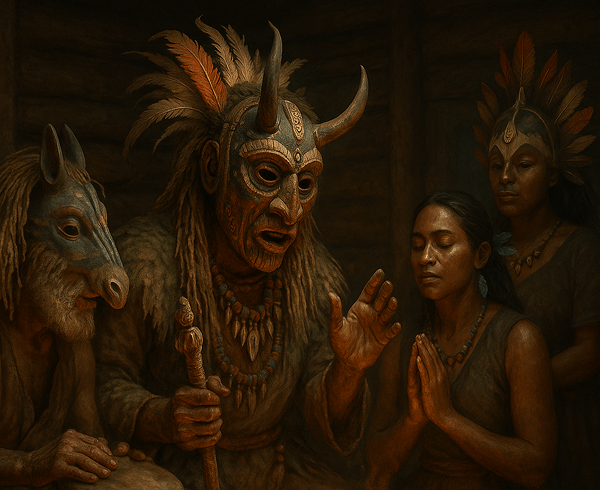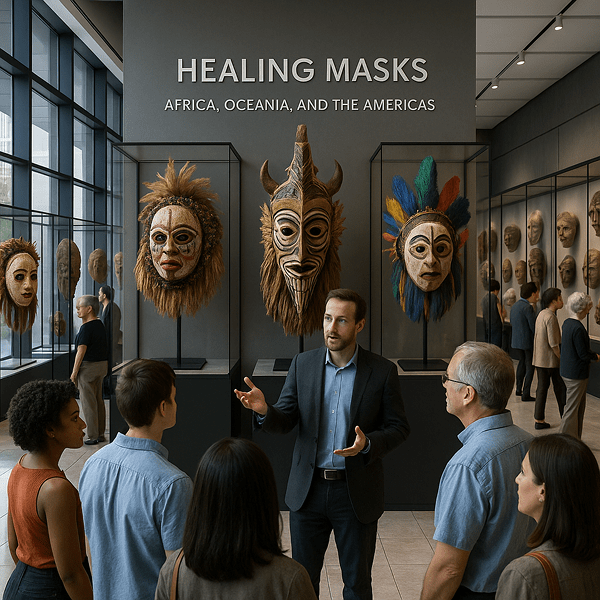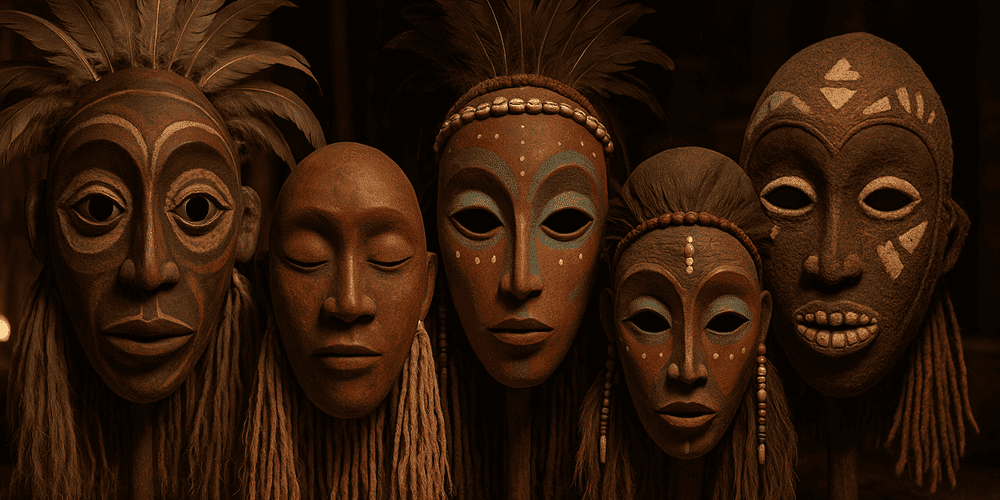Ritual Healing Masks are among the most intriguing and spiritually charged artifacts in the world’s sacred traditions. Crafted for use in ceremonies intended to restore health, harmony, and spiritual balance, these masks are instantly recognizable by their dramatic, often otherworldly features. They frequently display elongated faces, exaggerated eyes, symbolic patterns, and are adorned with feathers, shells, beads, raffia, or animal hair. The visual language of Healing Masks is both protective and enchanting, designed to inspire awe, induce altered states, and signal the presence of powerful healing forces. Healing Masks are especially prominent in sub-Saharan Africa, Oceania, the Americas, and Arctic regions, with each culture developing its own unique iconography and ritual role. Their origins often stretch back centuries, and their use continues in both traditional ceremonies and contemporary cultural revivals.
Historical Origins of Ritual Healing Masks
The history of Healing Masks is deeply intertwined with the rise of shamanistic, animistic, and ancestral traditions. The term “healing mask” refers to a mask used specifically in rituals to treat illness, expel evil, or restore the spiritual and physical well-being of individuals or communities. The English word “healing” comes from the Old English “hælan,” meaning to make whole or sound, while “mask” comes from Latin and Arabic roots referring to disguise or spirit. Archaeological evidence suggests that masks have been used in healing ceremonies since prehistory, with early examples found in burial sites, sacred caves, and rock art. Over time, the design and function of Healing Masks evolved in response to religious shifts, cultural exchange, and historical change. In Africa, for instance, masks of the Fang, Songye, and Pende peoples are central to healing and exorcism rituals. In the Arctic, Inuit shamans use spirit masks to communicate with animal spirits and restore balance. Throughout their history, Healing Masks have absorbed local myths, artistic styles, and sacred materials, resulting in a rich diversity of forms and meanings. The tradition of Spirit Masks, used to channel or appease supernatural forces, is closely related and often overlaps in function and symbolism.
Cultural Significance and Symbolism of Healing Masks
Healing Masks are imbued with profound cultural and spiritual meaning. In many societies, the mask is believed to embody or channel the presence of a healing spirit, ancestor, or deity. The wearer — often a shaman, priest, or healer — transforms into an intermediary between the worlds of the living and the supernatural, empowered to diagnose illness, expel malevolent forces, or restore lost vitality. The mask’s features — enlarged eyes, animal horns, painted patterns, or abstract forms — symbolize the particular powers or domains of the spirit, such as protection, fertility, wisdom, or transformation. Myths and legends recount the origins of specific masks and their miraculous abilities, from curing disease and infertility to bringing rain or warding off plague. Socially, Healing Masks reinforce community bonds, transmit cultural knowledge, and enact moral lessons, often through dramatic performances, music, and dance. The religious aspect is essential: masks are used to invoke ritual purity, ensure the success of healing rites, and maintain harmony between human and cosmic realms.

Materials and Craft Techniques of Healing Masks
The creation of Ritual Healing Masks is a highly respected and often sacred craft. Traditional masks are carved from local hardwoods, but may also incorporate bark, woven fiber, bone, clay, leather, or shells. Artisans use knives, chisels, adzes, and sometimes fire to shape and hollow the mask. Decoration is elaborate and symbolic: natural pigments (red ochre, white kaolin, black charcoal), beads, cowrie shells, feathers, raffia, and animal hair are applied using time-honored techniques. Special processes such as inlay, burning, or scarification may enhance the mask’s spiritual potency. Each region has its own stylistic conventions: African healing masks may feature animal motifs or movable jaws, while Arctic spirit masks may include articulated parts or fur. Color symbolism is crucial — red for life or danger, white for purity or ancestral spirits, black for protection or the unknown. Rituals often accompany the mask’s creation to imbue it with healing energy and spiritual force.
Functions and Uses of Healing Masks
Healing Masks have a wide range of ceremonial and ritual functions. In many cultures, they are worn by shamans or healers during ceremonies to treat illness, remove curses, or restore balance. The mask’s power is believed to derive from the spirit it channels, enabling the healer to enter trance, communicate with ancestors, or battle malevolent forces. In festivals and public rituals, Healing Masks may be used in dances, processions, or dramatic reenactments of mythological healing events, engaging the entire community in the ritual. Some masks are also used in rites of passage, agricultural ceremonies, or as part of exorcisms and purification rituals. Over time, the use of Healing Masks has adapted to changing contexts — today they appear in cultural exhibitions, contemporary art, and as symbols of identity and resilience. Their enduring presence highlights the ongoing importance of spiritual and communal healing in human societies.
Regional Variations of Healing Masks
Healing Masks display remarkable regional and cultural diversity. In West and Central Africa, masks such as the Songye Kifwebe, Fang Ngil, and Pende Mbangu are central to healing and exorcism rites. In Melanesia, Papua New Guinea, and Oceania, masks represent ancestral or nature spirits invoked for protection and cure. Among the Inuit and other Arctic peoples, spirit masks are used in shamanic healing and animal transformation rituals. Indigenous American traditions feature healing masks used in rainmaking, cleansing, and medicine ceremonies. Each region’s masks are shaped by local myths, cosmology, and social organization, yet all share the goal of restoring balance between people and the spirit world. Comparisons with Spirit Masks reveal both shared motifs and unique artistic traditions.
Famous Examples and Collections of Healing Masks
Some of the world’s most significant Healing Masks are preserved in museum and private collections. The Musée du Quai Branly (Paris), the Smithsonian National Museum of African Art (Washington, D.C.), and the British Museum (London) house renowned examples from Africa, Oceania, and the Americas. Notable artifacts include the Songye Kifwebe masks, the Pende Mbangu masks, and the Yup’ik spirit masks of Alaska. Important archaeological finds and early ethnographic collections offer insight into the history and evolution of these masks. Online resources and virtual galleries, such as toddmasks.com, provide access to high-resolution images and expert commentary, making Healing Masks accessible to a global audience.

Influence of Healing Masks on Art and Culture
Healing Masks have had a lasting impact on world art, literature, and performance. Their bold forms and symbolic power have inspired painters, sculptors, and filmmakers — most notably in the works of Picasso, Derain, and contemporary indigenous artists. In literature and cinema, healing masks often symbolize transformation, recovery, and the interplay between science and spirituality. Modern designers incorporate mask motifs in fashion, jewelry, and stage design, blending tradition with innovation. The preservation and reinterpretation of healing mask traditions play a vital role in cultural education, heritage conservation, and creative expression, both within source communities and worldwide.
Contemporary Status and Preservation of Healing Mask Traditions
Today, Ritual Healing Masks are both preserved and adapted by master artisans, communities, and cultural organizations. Traditional carving, painting, and ceremonial techniques are taught in workshops, festivals, and masterclasses, while contemporary artists experiment with new materials and digital media. Museums, universities, and online platforms such as toddmasks.com support research, documentation, and public engagement, ensuring the survival and appreciation of healing mask traditions. Community-based projects and educational programs help sustain living practices, while ethical collecting and documentation safeguard spiritual and cultural values for future generations.
Collecting and Acquiring Healing Masks
The market for Healing Masks is diverse, with authentic ritual pieces, high-quality replicas, and modern interpretations available from artisans, galleries, museums, and online platforms. Prices depend on age, craftsmanship, provenance, and cultural significance. Collectors are encouraged to seek expert advice, verify authenticity, and prioritize ethical sources that support local artists and communities. Toddmasks.com provides expert guidance on collecting, authentication, and ethical considerations. Responsible collecting helps ensure that masks are respected as cultural treasures and supports heritage preservation and community well-being.
